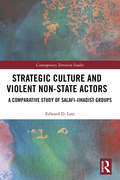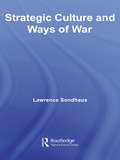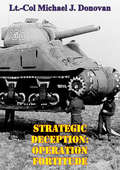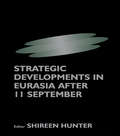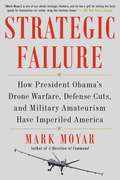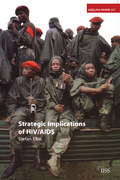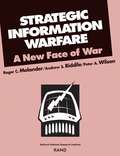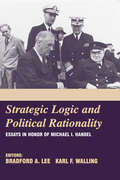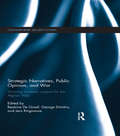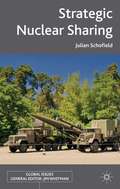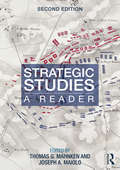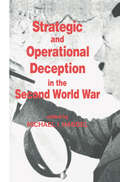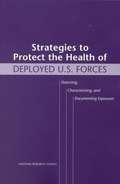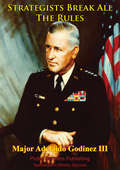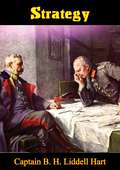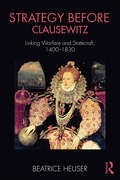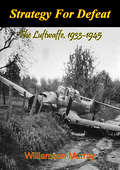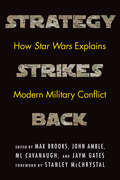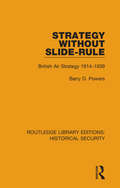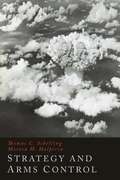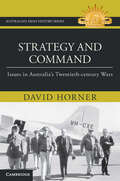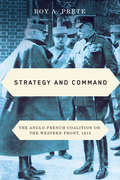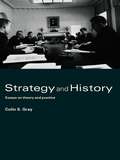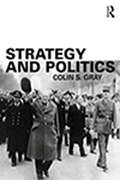- Table View
- List View
Strategic Culture and Violent Non-State Actors: A Comparative Study of Salafi-Jihadist Groups (Contemporary Terrorism Studies)
by Edward D. LastThis book applies strategic culture concepts to violent non-state actors (VNSAs) in a comparative analysis. In recent years, Al-Qaida in the Islamic Maghreb (AQIM) has become notorious for kidnapping Western hostages in north-western Africa and for its role in the short-lived Islamist takeover of Mali. The group, formerly known as the Salafist Group for Preaching and Combat, rebranded itself as an Al-Qaida franchise in 2007, leading to speculation of a change from its Algeria-centric agenda to an anti-Western one. This study compares and contrasts the ideas and behaviour of these two groups, using a strategic-cultural approach, and finds that, despite some commonalities, AQIM has a distinct strategic culture from Al-Qaida central, thereby debunking the notion of Al-Qaida as a monolithic movement. This is the first comparative analysis of violent non-state actors to employ a strategic-cultural approach and the first such study on AQIM. While strategic culture has traditionally been applied to states, this work adds to the emerging literature applying such approaches to non-state armed groups, and employs a novel conception of strategic culture consisting of narratives and practices. This book will be of much interest to students of strategic culture, political violence, Middle Eastern politics and Security Studies in general.
Strategic Culture and Ways of War (Cass Military Studies)
by Lawrence SondhausA much-needed survey and synopsis of literature on strategic culture and ways of war. It clearly shows how national strategies and approaches to warfare are, to a significant extent, culturally determined. The concept of national ‘ways of war’ dates from the 1930s, when Basil H. Liddell Hart theorized that there was a ‘British Way in Warfare’. The concept of "strategic culture" dates from the 1970s, when Jack Snyder introduced it to explain why leaders of the Soviet Union did not behave according to rational choice theory. These ideas have gained wide acceptance among historians of international politics and warfare, and remain controversial for political scientists seeking general or universal theoretical understanding of such subjects. Because political scientists have focused on strategic culture and historians on ways of war, this work will greatly benefit both audiences and provide each with valuable exposure to the ideas of the other.
Strategic Deception: OPERATION FORTITUDE
by Lt.-Col Michael J. DonovanThe Allied leaders decided to conduct the cross-channel invasion of Hitler's Fortress Europe in the first half of 1944 during the Tehran Conference held in November 1943. To support this invasion they also decided to implement a comprehensive deception campaign given the cover name BODYGUARD. The goal of BODYGUARD was to deceive Hitler and his senior military commanders about the location and timing of Allied offensive actions. Under the BODYGUARD umbrella, operation FORTITUDE was specifically designed to support the invasion of Normandy. FORTITUDE consisted of two primary operations. FORTITUDE-NORTH was designed to convince the Germans that the Allied invasion in 1944 would come through Norway and Sweden vice France. FORTITUDE-SOUTH was developed to convince Hitler and his staff that the primary invasion site in France would be Pas de Calais and other potential invasion sites, such as Normandy, were only diversions. The BODYGUARD and associated FORTITUDE operations were quite successful in fixing German forces, causing reserves to be committed piecemeal and basically paralyzing Hitler's decision making ability during the time of the Normandy landings and for weeks afterwards. The principles of current joint deception doctrine were applicable and utilized by the deception planners of General Eisenhower's staff long before the current Joint doctrine (Joint Publication 3-58, Joint Doctrine for Military Deception) was ever written.
Strategic Developments in Eurasia After 11 September
by Shireen HunterPresenting the views of leading experts on strategic considerations in Eurasia, this volume shows that the 11 September attacks and subsequent developments have affected the way in which international relations are evaluated. In addition, these developments have turned the concept of asymmetric threats, including large-scale international terrorist
Strategic Failure
by Mark MoyarA distinguished historian with over a decade inside the US Department of Defense shows how the downsizing of our armed forces lowers the nation's defense and puts us at risk.In this stunningly detailed account of US military power in the Obama era, Mark Moyar reveals how Obama's military decisions have led to the international catastrophes of his second term. While our current downward spiral did not grab the attention of the American people until 2014, Moyar finds its roots in Obama's first-term decisions to shrink the US military and replace large overseas military commitments with "light footprints." Obama's preoccupation with his political self-interest has consistently trumped the national interest. Moyar documents how Obama has failed to deliver on his substitutes for military power. Cutting through the chaff of partisan bickering with penetrating analysis, he homes in on the events and personalities driving failures across the globe. Moyar illustrates how Obama's policies led to the rise of ISIS, and how conditions are primed for future cataclysms. He shows how the killing of the US ambassador at Benghazi was the result of a light-footprint approach in Libya, and reveals the problems stemming from our reliance on drone strikes. The ongoing military drawdown and international perceptions of Obama's passivity have heightened the risks to America from her enemies. Drawing upon the lessons of Obama's presidency, Moyar concludes by identifying a better way for US national security in the twenty-first century. Strategic Failure is a timely and fascinating opening salvo in the looming 2016 showdown between Republican and Democratic presidential contenders.
Strategic Implications of HIV/AIDS (Adelphi series #Vol. 357)
by Stefan ElbeProvides an overview of the evolution of political Islam in South-east Asia. Analyses the sources of relgious radicalism and assesses the regional terrorist and radical networks. Describes how secular democratic institutions can be strengthened, and how moderate and tolerant tendencies can be promoted.
Strategic Information Warfare: A New Face of War
by Andrew Riddile Stephanie Williamson Peter A. Wilson Roger C. MolanderFuture U.S. national security strategy is likely to be profoundly affected by the ongoing, rapid evolution of cyberspace--the global information infrastructure--and in particular by the growing dependence of the U.S. military and other national institutions and infrastructures on potentially vulnerable elements of the U.S. national information infrastructure. To examine these effects, the authors conducted a series of exercises employing a methodology known as the Day After ... in which participants are presented with an information warfare crisis scenario and asked to advise the president on possible responses. Participants included senior national security community members and representatives from security-related telecommunications and information-systems industries. The report synthesizes the exercise results and presents the instructions from the exercise materials in their entirety.
Strategic Logic and Political Rationality: Essays in Honor of Michael I. Handel
by Bradford A. Lee Karl F. WallingOne of three volumes in honour of the teaching and scholarship of the late Michael I. Handel, this book details the universal logic of strategy and the ability of liberal-democratic governments to address this logic rationally.Treating war as an extension of politics, the diverse contributors (drawn from the United States, the United Kingdom, Australia and Israel) explore the difficulties in matching strategy to policy, especially in free societies.
Strategic Narratives, Public Opinion and War: Winning domestic support for the Afghan War (Contemporary Security Studies)
by Beatrice De Graaf Jens Ringsmose George DimitriuThis volume explores the way governments endeavoured to build and maintain public support for the war in Afghanistan, combining new insights on the effects of strategic narratives with an exhaustive series of case studies. In contemporary wars, with public opinion impacting heavily on outcomes, strategic narratives provide a grid for interpreting the why, what and how of the conflict. This book asks how public support for the deployment of military troops to Afghanistan was garnered, sustained or lost in thirteen contributing nations. Public attitudes in the US, Canada, Australia and Europe towards the use of military force were greatly shaped by the cohesiveness and content of the strategic narratives employed by national policy-makers. Assessing the ability of countries to craft a successful strategic narrative, the book addresses the following key areas: 1) how governments employ strategic narratives to gain public support; 2) how strategic narratives develop during the course of the conflict; 3) how these narratives are disseminated, framed and perceived through various media outlets; 4) how domestic audiences respond to strategic narratives; 5) how this interplay is conditioned by both events on the ground, in Afghanistan, and by structural elements of the domestic political systems. This book will be of much interest to students of international intervention, foreign policy, political communication, international security, strategic studies and IR in general.
Strategic Nuclear Sharing
by Julian SchofieldMost nuclear proliferation literature is focused on states seeking nuclear weapons, conducted in most cases clandestinely. The sharing of nuclear weapons technology between states is as important strategically, if unexpected, because nuclear weapons are such a powerful instrument in international politics. This book proposes to answer why, if nuclear weapons are such good preservers of peace, are states not more willing to see them proliferate? Schofield also examines the underlying phenomenon of the threat of proliferation races, and how nonproliferation bargains between adversaries make nuclear sharing far less common. But sharing is not rare. This book proposes a theory to explain nuclear sharing and surveys its rich history from its beginnings in the Second World War, including the cases of France Israel, US NATO, Russia China, Israel South Africa, China Pakistan and Pakistan Iran, as well as the incidence of soft balancing and permissive nuclear sharing in the cases of the US and Japan, Israel and India. "
Strategic Studies: A Reader (Studies In Strategic And Military History Ser.)
by Edited by Thomas G. Mahnken and Joseph A. MaioloThe second edition of Strategic Studies: A Reader brings together key essays on strategic theory by some of the leading contributors to the field. This revised volume contains several new essays and updated introductions to each section. The volume comprises hard-to-find classics in the field as well as the latest scholarship. The aim is to provide students with a wide-ranging survey of the key issues in strategic studies, and to provide an introduction to the main ideas and themes in the field. The book contains six extensive sections, each of which is prefaced by a short introductory essay: The Uses of Strategic Theory Interpretation of the Classics Instruments of War, Intelligence and Deception Nuclear Strategy Irregular Warfare and Small Wars Future Warfare, Future Strategy Overall, this volume strikes a balance between theoretical works, which seek to discover generalisations about the nature of modern strategy, and case studies, which attempt to ground the study of strategy in the realities of modern war. This new edition will be essential reading for all students of strategic studies, security studies, military history and war studies, as well as for professional military college students.
Strategic and Operational Deception in the Second World War (Studies in Intelligence)
by Michael I. HandelFirst Published in 1987. Routledge is an imprint of Taylor & Francis, an informa company.
Strategies of Containment: A Critical Appraisal of American National Security Policy During the Cold War (Revised and Expanded Edition)
by John Lewis GaddisWhen Strategies of Containment was first published, the Soviet Union was still a superpower, Ronald Reagan was president of the United States, and the Berlin Wall was still standing. This updated edition of Gaddis' classic carries the history of containment through the end of the Cold War. Beginning with Franklin D. Roosevelt's postwar plans, Gaddis provides a thorough critical analysis of George F. Kennan's original strategy of containment, NSC-68, The Eisenhower-Dulles "New Look," the Kennedy-Johnson "flexible response" strategy, the Nixon-Kissinger strategy of detente, and now a comprehensive assessment of how Reagan-- and Gorbachev-- completed the process of containment, thereby bringing the Cold War to an end. He concludes, provocatively, that Reagan more effectively than any other Cold War president drew upon the strengths of both approaches while avoiding their weaknesses. A must-read for anyone interested in Cold War history, grand strategy, and the origins of the post-Cold War world.
Strategies to Protect the Health of Deployed U.S. Forces: Detecting, Characterizing, and Documenting Exposures
by Strategies to Protect the Health of Deployed U.S. Forces: Technology Methods For Detection Tracking of Exposures to a Subset of Harmful AgentsA report on Detecting, Characterizing, and Documenting Exposures
Strategists Break All The Rules
by Major Adelaido Godinez IIIEmory Upton believed that politicians should leave war to professionals. This led to two assumptions that became conventional wisdom: first, an apolitical army represented a more professional force; and second, the problems at the tactical and operational level were similar enough to be useful in developing strategic thinking. These assumptions resulted in what Samuel P. Huntington described as the "normal-theory" relationship between policy-makers and generals. The assumption made sense for the United States but had one unfortunate result. The Army as an institution misread the nature of an apolitical force. The essence of an apolitical force should be non-partisan -Army professionals above political interference or interest. There is a difference, however, between policy and politics. While not involving itself in the political life of the nation, the Army is vitally concerned with the policies of the nation. The discussion strategists must prepare for are political, but in the nature of policy as the object of war. A historical survey of strategists from General Winfield Scott to General Creighton Abrams suggests that the most successful strategists are life-long learners. They build holistic understanding of the interdependent and infinite connections of the whole problem. Once they develop a hypothesis about the whole problem, they reshape those connections to create a better peace for the United States. Strategists that take time to understand the whole problem encourage discourse. Retaining the Functional Area 59 Strategist program will continue to benefit the force because they do not follow a traditional route to generalship. After all, few have earned stars by arguing, debating, and taking intellectual risk.
Strategy
by Captain B. H. Liddell HartThis is the classic book on war as we know it. During his long life, Basil H. Liddell Hart was considered one of the world's foremost military thinkers--a man generally regarded as the "Clausewitz of the 20th century." Strategy is a seminal work of military history and theory, a perfect companion to Sun-tzu's The Art of War and Carl von Clausewitz's On War.Liddell Hart stressed movement, flexibility, and surprise. He saw that in most military campaigns dislocation of the enemy's psychological and physical balance is prelude to victory. This dislocation results from a strategic indirect approach. Reflect for a moment on the results of direct confrontation (trench war in WWI) versus indirect dislocation (Blitzkrieg in WWII). Liddell Hart is also tonic for business and political planning: just change the vocabulary and his concepts fit.-Print ed."The most important book by one of the outstanding military authorities of our time."--Library Journal
Strategy Before Clausewitz: Linking Warfare and Statecraft, 1400-1830 (Cass Military Studies)
by Beatrice HeuserThis collection of essays combines historical research with cutting-edge strategic analysis and makes a significant contribution to the study of the early history of strategic thinking. There is a debate as to whether strategy in its modern definition existed before Napoleon and Clausewitz. The case studies featured in this book show that strategic thinking did indeed exist before the last century, and that there was strategy making, even if there was no commonly agreed word for it. The volume uses a variety of approaches. First, it explores the strategy making of three monarchs whose biographers have claimed to have identified strategic reasoning in their warfare: Edward III of England, Philip II of Spain and Louis XIV of France. The book then analyses a number of famous strategic thinkers and practitioners, including Christine de Pizan, Lazarus Schwendi, Matthew Sutcliffe, Raimondo Montecuccoli and Count Guibert, concluding with the ideas that Clausewitz derived from other authors. Several chapters deal with reflections on naval strategy long thought not to have existed before the nineteenth century. Combining in-depth historical documentary research with strategic analysis, the book illustrates that despite social, economic, political, cultural and linguistic differences, our forebears connected warfare and the aims and considerations of statecraft just as we do today. This book will be of great interest to students of strategic history and theory, military history and IR in general.
Strategy For Defeat: The Luftwaffe, 1933-1945 [Illustrated Edition]
by Williamson MurrayIncludes the Aerial Warfare In Europe During World War II illustrations pack with over 200 maps, plans, and photos.This book is a comprehensive analysis of an air force, the Luftwaffe, in World War II. It follows the Germans from their prewar preparations to their final defeat. There are many disturbing parallels with our current situation. I urge every student of military science to read it carefully. The lessons of the nature of warfare and the application of airpower can provide the guidance to develop our fighting forces and employment concepts to meet the significant challenges we are certain to face in the future.
Strategy Strikes Back: How Star Wars Explains Modern Military Conflict
by Max Brooks Jaym Gates John Amble Ml Cavanaugh Gen. Stanley McChrystalThe most successful film franchise of all time, Star Wars thrillingly depicts an epic multigenerational conflict fought a long time ago in a galaxy far, far away. But the Star Wars saga has as much to say about successful strategies and real-life warfare waged in our own time and place. Strategy Strikes Back brings together over thirty of today’s top military and strategic experts, including generals, policy advisors, seasoned diplomats, counterinsurgency strategists, science fiction writers, war journalists, and ground‑level military officers, to explain the strategy and the art of war by way of the Star Wars films. Each chapter of Strategy Strikes Back provides a relatable, outside‑the‑box way to simplify and clarify the complexities of modern military conflict. A chapter on the case for planet building on the forest moon of Endor by World War Z author Max Brooks offers a unique way to understand our own sustained engagement in war-ravaged societies such as Afghanistan. Another chapter on the counterinsurgency waged by Darth Vader against the Rebellion sheds light on the logic behind past military incursions in Iraq. Whether using the destruction of Alderaan as a means to explore the political implications of targeting civilians, examining the pivotal decisions made by Yoda and the Jedi Council to differentiate strategic leadership in theory and in practice, or considering the ruthlessness of Imperial leaders to explain the toxicity of top-down leadership in times of war and battle, Strategy Strikes Back gives fans of Star Wars and aspiring military minds alike an inspiring and entertaining means of understanding many facets of modern warfare. It is a book as captivating and enthralling as Star Wars itself.
Strategy Without Slide-Rule: British Air Strategy 1914–1939 (Routledge Libary Editions: Historical Security)
by Barry D. PowersThe early history of British aerial defence development is one of misdirection and delusion. The misdirection, judging by the criteria of successful aerial defence in World War II, was primarily in the downgrading of home defence measures including the fighter plane. The delusion, again judging by Britain’s efforts in that second world war, was primarily in the assumption of the effects to be obtained by strategic bombing. In both cases, the First World War was a major catalyst. Although events and writings before that war indicate the coming patterns, it was during that war that a great amount of the patterns are well established. Originally published in 1976, this work explores these origins and stresses the interaction between various diverse segments of English society in the formation of the major patterns. The working out of these patterns in the first half of the interwar years is also analysed, again with respect to diverse groupings in Britain.
Strategy and Arms Control
by Thomas C. Schelling Morton H. HalperinThis study is an attempt to identify the meaning of arms control in the post war period. It presents an analysis of arms control with particular emphasis on the military policy involved. The general objectives of the study is to advance some aspects of the intellectual state of the art in arms control and to provide some concrete data on the technical and strategic problems of importance.
Strategy and Command: Issues in Australia's Twentieth-century Wars (Australian Army History Series)
by David HornerIn Strategy and Command, David Horner provides an important insight into the strategic decisions and military commanders who shaped Australia's army history from the Boer War to the evolution of the command structure for the Australian Defence Force in the 2000s. He examines strategic decisions such as whether to go to war, the nature of the forces to be committed to the war, where the forces should be deployed and when to reduce the Australian commitment. The book also recounts decisions made by commanders at the highest level, which are passed on to those at the operational level, who are then required to produce their own plans to achieve the government's aims through military operations. Strategy and Command is a compilation of research and writing on military history by one of Australia's pre-eminent military historians. It is a crucial read for anyone interested in Australia's involvement in 20th-century wars.
Strategy and Command: The Anglo-French Coalition on the Western Front, 1915
by Roy A. PreteFalling between the “War of Movement” in 1914 and the major attrition battles of 1916, 1915 was a critical year in the First World War. As France failed in ever-larger offensives to break through the German trenches, Britain shifted its strategy from defence of empire to total commitment to the continental war.In the second of three planned volumes, Roy Prete analyzes the political and military policies and strategies of Britain and France and their joint command relationship on the Western Front in 1915. The opposing strategies of the two governments proved to be the main determinant in the sometimes ragged relations between the French commander-in-chief, Joseph Joffre, and his British counterpart, Sir John French, as they sought to drive the German army out of France and to aid their hard-pressed Russian ally. With an impressive marshalling of evidence, Strategy and Command demonstrates that the increased British commitment to the continental war, manifested in sending Kitchener’s New Armies to France in 1915, was largely due to the disastrous situation of the Russian army on the Eastern Front and the perceived weakness of the French government.Based on extensive research in French and British political and military archives, this new in-depth study of Anglo-French military relations on the Western Front in 1915 fills a major gap in the unfolding drama of the First World War.
Strategy and History: Essays on Theory and Practice (Strategy and History)
by Colin S. GrayStrategy and History comprises a selection of Professor Gray's key contributions to strategic debate over the past thirty years. These essays have been selected both because they had significant messages for contemporary controversies, and because they have some continuing relevance for today and the future. Each essay in this book is really about strategy in the modern world, and reflects the many dimensions of this complex subject. This book covers a wide range of subjects and historical events, but there are key issues covered throughout: being strategic the consequences of actions a respect for Clausewitz’s theory of war historical dependency the importance of geography being critical of enthusiasm for technology over human factors the primacy of politics. This important publication provides an invaluable insight into the development of strategic studies over the past 30 years from one of the world's leading theorists and practitioners of the subject. The book will be of great interest to all students and analysts of strategy and international studies.
Strategy and Politics
by Colin S. GrayThis book examines the subject of strategy and its relationship with politics. Despite the fact that strategy is always the product of political process, the relationship between the two concepts and their ancillary activities has scarcely been touched by scholars. This book corrects that serious deficiency, and explains the high relevance of political factors for matters of general defence. Each chapter aims to show how and why strategy and politics interact and how this interaction has had significant consequences historically. Neither strategy nor politics can make sense if considered alone. Strategy requires direction that can only be provided by political process, while politics cannot be implemented without strategy. In summary, this volume will explain: what strategy is (and is not) why strategy is essential what strategy does and how it does it how strategy is made and executed Written by a leading scholar and former practitioner, this book will be essential reading for all students of military strategy, strategic studies, security studies and war and conflict studies.
